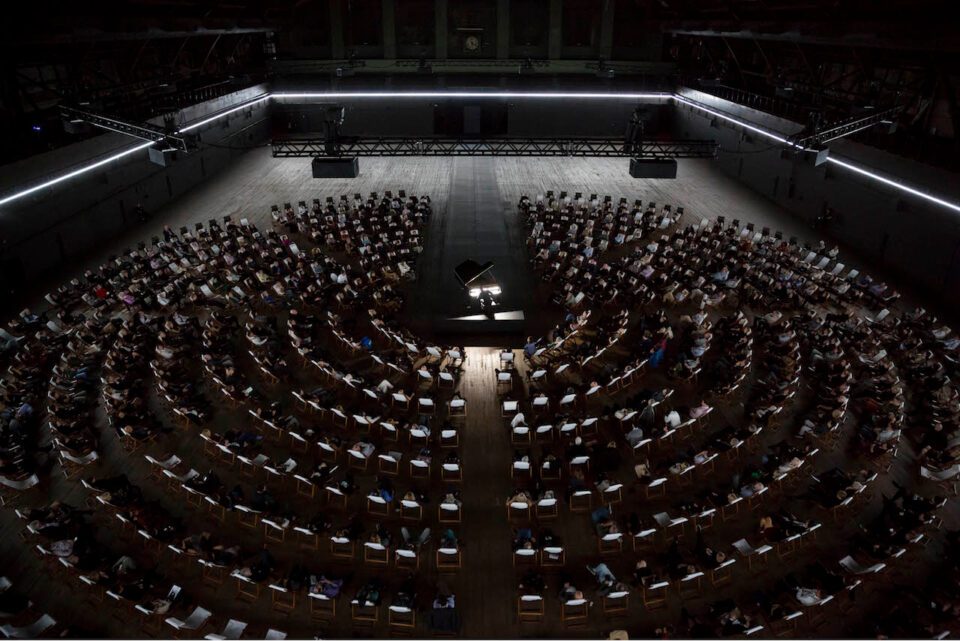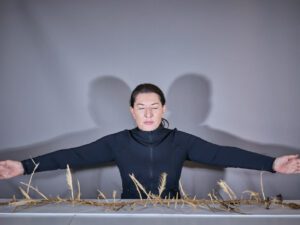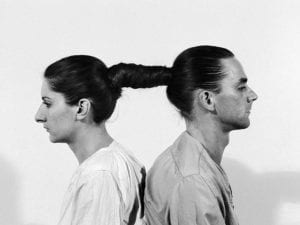The art of Marina Abramovic, notorious for her radical and physically enduring performances, is in the process of constant transformation. In her latest and largest project in New York since her retrospective at the Museum of Modern Art, Abramovic decided to work with classical music for the first time. “Music goes through your body, through molecules of your skin. There is no object in between. Music is on top of the pyramid of immaterial art,” she proposes during our interview in between the performances. With this passion cutting a tough and (dangerously) thorny path across the decades, she has forged a new method to sound and what its performance could be.
Goldberg (Bach’s piano variations) was created in collaboration with Russian-German pianist Igor Levit and, for the first time in living memory, performed here in its entirety. For this performance, at Manhattan’s Park Avenue Armory, the pleasure of our attendance is immediately challenged as Abramovic characteristically imposes sets of rules: we leave our cell phones, watches, and other electronic devices, as well as handbags of any kind in specially installed locker rooms. Next, we put on noise-cancelling headphones and sit in silence for approximately 30 minutes in exclusively designed chairs, before the performance begins. It isn’t disclosed for how long the silence will last. It feels slightly uncomfortable, until one loses count of time and gives up completely to the master plan of Marina. “For any kind of experience you need discipline. Any master in Buddhism, or any mystic, or a ceremony in any culture deals with very difficult conditions. You don’t get the experience if you don’t put in the effort,” she laughs.
Time stands still at an Abramovic durational performance: there you still are, deprived of a smartphone to check absent-mindedly, so you look around and back to follow the spotlight installation flow: one usher appears as a doll that was forgotten there, another, as a ballerina poised to plié. “The initial 10 minutes of that silent eternity is hell,” explains Marina, “See, I don’t even give them a program to read, I don’t give them anything! They just have to be with themselves and they don’t know how to do that, but eventually they have to figure out, okay, now it is just me.” It is alien, the way Levit makes his entrance into the space (there is no stage per se, or if there is, then you’re right there with a hundred other parts of its installation: the audience), floating furtively along with the piano towards the centre. Then you realise that this pianist is a mere attachment to the piano, and also that his journey, as well as the very gradual clockwise rotation of the whole installation, is not a product of your imagination. Nor is Marina Abramovic herself, standing amongst the audience and applauding smilingly at the end. It all makes us equal in a way: the auxiliary to his instrument, Igor, the crowd in scarves and coats, the mysterious Abramovic, all music devotees.
“First of all it took me two or three years to make a new piece. I will never stop performing, but now I can see more and more that what interests me is when the public itself becomes my work, and when I have a duty of transmitting the knowledge to the younger generation of artists”. The Abramovic Method, which now is being applied to listening to the music, was created with the contemporary audience in mind: it involves different exercises to heighten consciousness and being present in the moment. Ambramovic has a method for how to drink a glass of water. How to count rice. How to stand still. “We’ve become very restless human beings. We don’t have time for anything,” Abramovic argues. “I realised that if you want to get deeper into anything you have to find a centre within yourself, and this is my problem too! I couldn’t concentrate for the performance just within five minutes, I needed much longer time. And I realised that the public would require even longer than myself. ”
The Method proves is in high demand at the Marina Abramovic Institute, founded by her in New York State, and home to long durational works which at last has opened its doors, after raising $660,000 on Kickstarter. Here, guests will have to sign an agreement with Marina that they are willing to stay in the museum for at least six hours, which reflects the emotional connection she has established with followers, but also speaks to her audience’s appetite for structure and discipline.
Whereas Goldberg relates to her recent practice of durational performances, her early work in the mid 1970s when she first gained prominence was more conceptual, and radical in many ways, dealing with more physical risks and symbolism. Even her approach to sound, which was her way into performance art was conceptual back then: “I put the speakers at the edifice with the sound of a building crashing down,” she tells us, “and you are standing right there. Visually the house is intact but your aural perception tells you that it is in a process of collapsing, which creates a truly interesting split in your consciousness, I was very into that.” In other performances she has laid in a large star set on fire until she lost consciousness, cut her stomach with a razor blade, and stood still for hours while her then-collaborator and partner Ulay aimed an arrow at her heart.
While retrograde fans might still expect radical things, or mindshifting one-to-one meditative experiences like they saw at MoMa, Marina has absconded to a new experiential plateau, as if defying even her own public to catch up with her. “My ideas come out of nowhere. But I have to be completely quiet when this happens. This is why I am going to India now to get away from all the distraction. I am going to this place where they give you three pajamas. You stay there for a month and you don’t do anything. Doing nothing for me is the base of everything.”
She educates us during the interview about virtual reality: it constitutes the future of art. Perhaps over time, technology will transform her once more, but for now, Goldberg is a shockingly simple analogue, a refined piece that encourages the observer to adjust their expectations, all accomplished with beauty, vision, and the Abramovic Method turning the equation back on the audience. “It is interesting how people would still like to see me splashing blood and me cutting myself. I am bored with this. I have done it. I am not interested in repeating myself. I am more interested in showing the public themselves. When I performed people cried, now they can cry even without me.”
Olga Zavarzina and Masha Froliak
Goldberg showed at Park Avenue Armory, New York, from 7-19 December 2015.
Learn more at www.armoryonpark.org.
Follow us on Twitter @AestheticaMag for the latest news in contemporary art and culture.
Credits
1. Marina Abramovic and Igor Levit, Goldberg, 2015. Courtesy of Park Avenue Armory and James Ewing.





